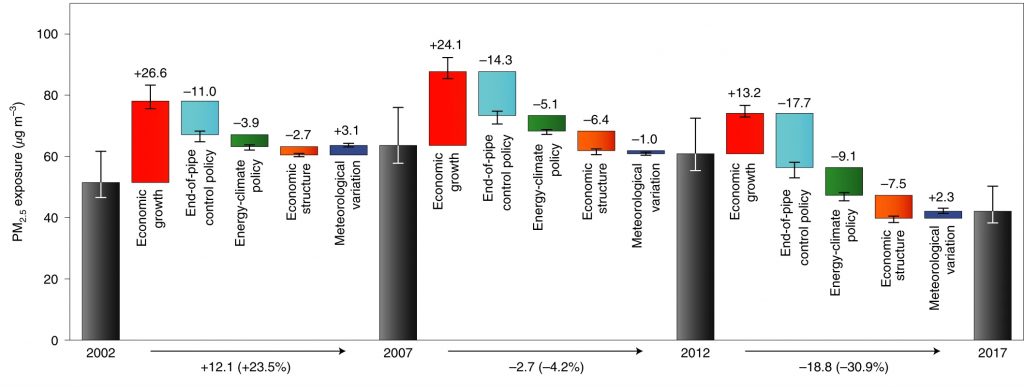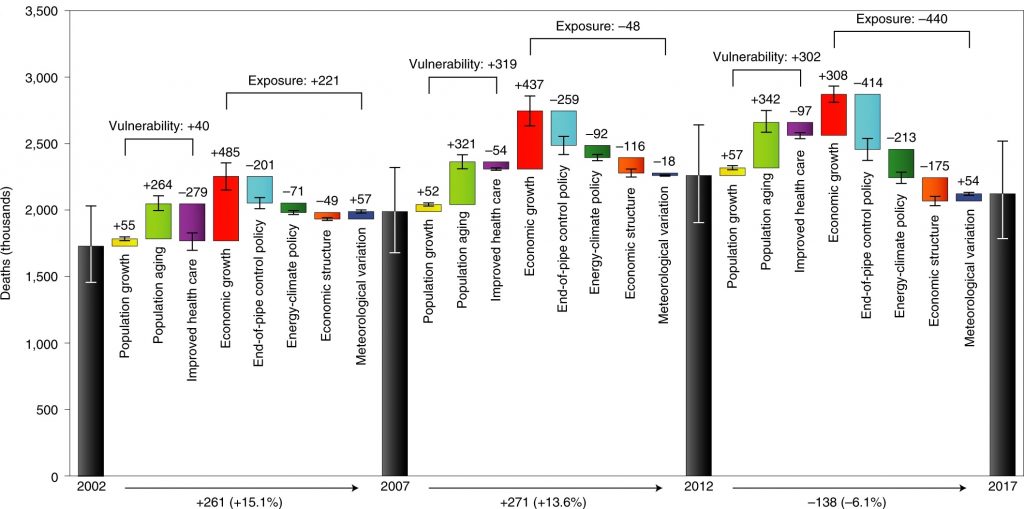2021-07-26 | Guannan Geng
On July 26, the MEIC team published a paper entitled “Drivers of PM2.5 air pollution deaths in China 2002–2017” online in Nature Geoscience, which systematically analyzed the long-term trends and main drivers of atmospheric fine particulate matter (PM2.5) pollution and its health effects in China during 2002-2017. The impact of a total of 8 factors in 4 aspects, including social and economic development, energy-climate policies, changes in meteorological conditions, and population vulnerability, on PM2.5 pollution and death risks was quantified in the paper.
The current level of atmospheric PM2.5 pollution in China far exceeds the recommended value of the World Health Organization (WHO), posing a serious threat to public health. PM2.5 pollution is influenced by many natural and anthropogenic factors. Clarifying the drivers of PM2.5 pollution changes is a common concern for the scientific community and policymakers, which is significant for analyzing the causes of pollution sources and effectively formulating control strategies. Meteorological condition is an important natural factor affecting PM2.5 pollution, and its interannual variation may have a non-negligible impact on the long-term trend of PM2.5 concentration changes. In terms of anthropogenic factors, economic growth leads to an increase in fossil energy consumption, which aggravates PM2.5 pollution; a series of policied implemented by the government to improve energy efficiency, optimize energy structure, and end-of-pip control will reduce pollutant emissions and mitigate PM2.5 pollution level; in addition, the health loss caused by PM2.5 pollution is also influenced by social factors such as the degree of population aging and medical conditions. Thus, the long-term changes in PM2.5 pollution and the subsequent health effects are the results of the combined effects of the above-mentioned complex natural and anthropogenic factors. Previous studies have quantitatively decomposed the contributions of some of these factors. However, a comprehensive understanding of the impact of various natural and anthropogenic factors on PM2.5 pollution and its health impacts requires the construction of a deep cross-coupled technical approach between natural and social sciences, and a breakthrough has not been achieved for a long time.
To address the above problems, the MEIC team designed a multidisciplinary modeling approach at the intersection of atmospheric science, environmental science, and economics to reveal the complex nonlinear correlation mechanism between socio-economic and atmospheric environmental systems by coupling anthropogenic emission inventory models, index decomposition methods, chemical transport models, and health effects models. For the first time, we quantitatively decomposed the contributions of eight major factors, including economic growth, end-of-pipe control policy, energy-climate policy, economic structure optimization, interannual meteorological variation, population growth, population aging, and improved health care, to long-term changes in atmospheric PM2.5 pollution and health effects in China.

The study found that the risk of premature deaths attributable to PM2.5 pollution in China increased from 1.73 million people per year to 2.12 million people per year between 2002 and 2017, an increase of 23% in 15 years. Among them, the surge in fossil energy consumption due to rapid economic growth was one of the leading factors contributing to the increased mortality risk, which increased the PM2.5-related mortalities by 1.23 million, while the implementation of end-of-pipe policies avoided the mortality risk of 0.87 million people, offsetting approximately 70% of the increment due to economic growth. Energy structure transformation and economic structure optimization also contributed significantly to air pollution improvement, together with avoiding a premature death risk of 0.72 million people. From 2012 to 2017, with the promulgation of the Air Pollution Prevention and Control Action Plan (the “Action Plan”), the end-of-pipe control and energy structure transformation measures have been significantly strengthened, pushing China’s PM2.5-related death risks to a turning point of decrease.
Moreover, the study found that the changes in meteorological conditions tended to be unfavorable during 2002-2017, leading to an increase in the risk of PM2.5 pollution-related deaths by 90 thousand people in China. In terms of population vulnerability, PM2.5 pollution had a more severe impact on the health of the elderly, with population growth and increasing aging combined increasing the risk of PM2.5-related deaths by 1.09 million people between 2002 and 2017, while improved health care averted the risk of 0.43 million deaths.

The study is the first to quantitatively assess the main drivers of historical long-term changes in PM2.5 pollution and health impacts in China, and the findings are important guidance for China to formulate the next air pollution prevention and control policies and achieve sustainable air quality improvement. Although PM2.5 concentrations in China have decreased significantly in recent years, there is still a large gap from the WHO guideline standards, and the problem of ozone (O3) is becoming increasingly prominent, so the synergistic control of PM2.5 and O3 is imminent. At the same time, the problem of population aging in China has become increasingly serious, and the vulnerability of the population to air pollution has gradually increased. Therefore, more stringent clean air policies are needed in the future to protect public health.
With the deepening of the atmospheric pollution control process, China’s air pollutant emission reduction has entered a deep-water zone, the dividends of end-of-pipe control are difficult to sustain, with the difficulty of further emission reduction increasing. The results of the study found that the structural transformation implemented during the “Action Plan” from 2012 to 2017 was an important factor in driving down PM2.5 pollution levels. In the context of the major strategic objectives of carbon emission peaking and carbon neutrality, we should reduce pollutant and carbon emissions at the same time enhancing the synergy between them in the future, accelerate the transformation from end-of-pipe control to source control, release the pollution reduction potential of energy, industry, transportation, and land use restructuring, accelerate the clean and low-carbon shift of energy, and promote the long-term sustainable improvement of air quality.
